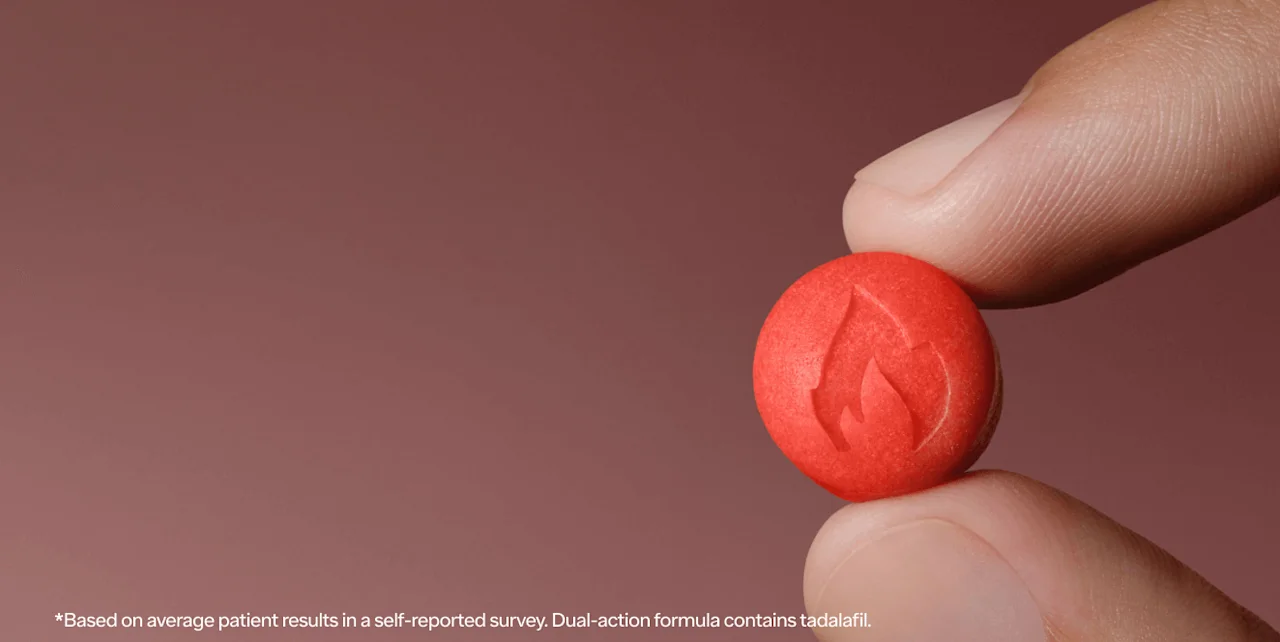Key takeaways
A 7-inch penis is considered above average in length, as most reliable studies found that the typical erect penis size is between about 5.1 and 5.5 inches.
Research shows results vary depending on how measurements are taken, but the consensus is that seven inches is longer than what most people have.
Myths around size and masculinity are common, yet studies highlight that satisfaction and confidence depend more on communication, chemistry, and technique than length alone.
If sex feels uncomfortable for a partner, or if issues like erectile dysfunction or premature ejaculation come up, talking to a healthcare provider can help.
Here's what we'll cover
Here's what we'll cover
Here's what we'll cover
Key takeaways
A 7-inch penis is considered above average in length, as most reliable studies found that the typical erect penis size is between about 5.1 and 5.5 inches.
Research shows results vary depending on how measurements are taken, but the consensus is that seven inches is longer than what most people have.
Myths around size and masculinity are common, yet studies highlight that satisfaction and confidence depend more on communication, chemistry, and technique than length alone.
If sex feels uncomfortable for a partner, or if issues like erectile dysfunction or premature ejaculation come up, talking to a healthcare provider can help.
When it comes to penises, questions about size come up a lot. You’re probably here because you’re wondering where a 7-inch penis ranks.
Research shows the average penis measures up to approximately 5.5 inches when erect, which makes a 7-inch penis above average. But numbers don’t tell the whole story. The size that feels comfortable in real life depends on factors such as girth (circumference), proportions, and partner comfort, and bigger doesn’t automatically mean better.
This guide breaks down what a 7-inch penis really means, how it compares to averages, and what matters most for sexual satisfaction.
Is a 7-inch penis big?
Yes, a 7-inch penis is bigger than average when you look at the numbers.
Exactly how much bigger depends on which study you look at, but most reliable research puts the “typical” erect penis somewhere between 5.1 and 5.5 inches. That means seven inches sits well above that.
The numbers: how 7 inches compares to the average
A 2021 analysis looked only at studies where trained professionals took the measurements. They found the average stretched penis length was 5.1 inches, and the average erect length across 10 studies was 5.36 inches.
Since stretched length is considered close to erect length, the researchers concluded the “true” average likely falls between 5.1 and 5.5 inches.
More recent research published in 2023 pulled together data from 75 studies and over 55,000 people with a penis worldwide. The average erect penis length in this analysis was 5.5 inches. (This study included self-reported measurements, though.)
The researchers also noticed something interesting: even after adjusting for geographic region, age, and the subject populations, average erect size has increased by about 24% since the 1990s. We don’t know why, but it could reflect changes in lifestyle, nutrition, measurement methods, or even selection bias.
Sometimes, individual studies show results that are different from averages found in meta-analyses.
One study, which included more than 4,600 people, found that the average erect length was 6.6 inches, with an average girth of 4.7 inches. This is one of the higher averages reported, illustrating how results can vary significantly between studies.
In another case, one study measured 800 people and found the average stretched length was six inches, with an average girth of four inches. While stretched size isn’t identical to erect size, it's a good proxy, which, again, puts seven inches a solid inch above average.
Instead of relying on individual studies or self-reports, some researchers have pulled together thousands of measurements to create reference charts of what’s “typical.” Those charts indicate an average erect length of about 5.2 inches, with an average girth of 4.6 inches.
Although numbers vary from study to study, the pattern remains consistent: most people fall within the 5–6 inch range.
Average erect length | What it means for 7 inches |
|---|---|
5.2 inches | A solid 1.8 inches longer |
5.3 inches | About 1.7 inches longer |
5.5 inches | Well above average |
6 inches | Around an inch longer |
6.6 inches | Slightly longer |
Why the numbers vary so much
One study says 5.1 inches, another says 6.6 inches — so what gives? A lot comes down to how the data were collected:
Self-reported sizes tend to run bigger (people may round up or measure differently).
Volunteer bias means people who feel confident about their size are more likely to sign up for studies.
Some studies use stretched flaccid length instead of erect length, which is a reasonable approximation but not quite the same measurement.
So while the exact average shifts depending on the study, the bottom line is pretty consistent: seven inches is bigger than what most people have.
Common myths about 7-inch penises
A 7-inch penis isn’t average, and it doesn’t automatically guarantee a better sex life or say anything about your masculinity. Here’s what the research actually shows.
Myth 1: 7 inches is the average penis size
It’s not. Most large-scale studies show the average erect penis is closer to 5–6 inches long, with an average girth of about 4.7 inches. That means seven inches is above average, not the norm.
So why do so many people think “average” is bigger than it really is? A lot of it comes down to perception. Porn often shows those with a penis at the larger end of the spectrum, which can distort expectations.
Myth 2: Bigger is always better
Not necessarily. While size can matter to some people, most research shows it’s far less important than some might believe. In a survey of 170 women, more than 75% said penis length wasn’t important to their sexual satisfaction, and only about 1% considered it “very important.”
More research found that women’s preferences for penis size were only slightly above the average, just over six inches in length and around five inches in girth. In other words, we’re talking about a small difference, not the exaggerated sizes often shown in porn.
What really makes sex satisfying has less to do with size and more to do with the overall experience. In interviews with people of different ages and backgrounds, three themes came up again and again when they described “great sex”: orgasm, emotional connection, and chemistry.
For many, trust and affection made it easier to be present and enjoy themselves, while others emphasized the importance of chemistry and genuine connection.
In short, technique, communication, and emotional investment consistently played a bigger role in satisfaction than an extra inch ever could.
Myth 3: Size determines masculinity
A bigger penis doesn’t make someone “more of a man.” Research shows adult testosterone levels and penis size aren’t directly linked, and those with shorter lengths are not less masculine.
What the research does show is that many feel pressure to exaggerate or worry about their size. In one study of college students, the average self-reported erect length was 6.6 inches, noticeably larger than the average length that researchers found when they took the measurements themselves.
Nearly a third of the people in that study reported being seven inches or more, which is unlikely given the rarity of such a measurement. The researchers concluded that many were probably rounding up or exaggerating, often influenced by social desirability.
These insecurities can chip away at sexual confidence, even when there’s nothing physically “wrong.”
What 7 inches actually looks like
It can be hard to picture what seven inches really means in everyday life. To put it into perspective, seven inches is about the length of:
A standard butter knife or large serving spoon 🥄
An adult toothbrush 🪥
A typical tablet screen 💻
Two playing cards laid end to end 🃏
A medium-sized banana 🍌
When you translate the number into objects you use every day, it’s easier to see why seven inches is considered larger than average.
Girth plays a significant role in how large a penis looks and feels, and body proportions can change the visual impression, too. Research found almost no real link between penis size and things like height, weight, or even foot size, even though people often assume those traits go hand in hand.
That means a 7-inch penis can look or feel different depending on the person’s build, their partner’s anatomy, and its girth, not just its length.
How to enhance sexual experiences with a 7-inch penis
Having a larger-than-average penis can be a source of confidence, but it sometimes comes with practical challenges during sex. With the proper preparation and techniques, you can make the experience more comfortable and enjoyable for both you and your partner.
Essential techniques for a larger size
With more length and girth, it’s especially important to pace yourself. Gentle entry, using plenty of lubrication, and paying attention to your partner’s cues can help prevent discomfort.
Many people find that experimenting with positions that allow for more control over depth also makes sex more pleasurable. Research on how often those with a vagina reach orgasm during intercourse shows that positions like face-to-face or with the receiving partner on top often work especially well.
In these, the partner that’s on top and can set the pace, angle, and depth, which helps keep things comfortable and increases the chances of orgasm. Sitting face-to-face positions also give both partners more control while adding intimacy.
This doesn’t mean that other positions are off-limits, just that they might take more communication or slower movement to balance comfort and pleasure.
Foreplay and preparation strategies
Good sex isn’t just about penetration. Take time for foreplay like kissing, touching, or oral sex to help your partner build arousal.
Studies on those with vulvar pain show that even when pain is present, pleasure is still very possible, especially when stimulation focuses on areas like the clitoris rather than relying only on penetration. In fact, external stimulation was more likely to lead to orgasm than penetration.
Condom selection and safety
Condom fit matters even more when you’re on the bigger side. Research shows that those with penises in the 6–8 inch length and 4–6 inch girth ranges are more likely to report that standard condoms feel too tight or break during use.
If a condom is too small, it increases the risk of slippage or tearing, which can raise the chance of sexually transmitted infections or unintended pregnancy.
Don’t hesitate to try different brands or sizes until you find the right fit. A condom that rolls on easily and feels snug (but not restrictive) is the safest option.
When to seek professional guidance
For many people, worries about size or performance come and go. But if concerns are persistent or start interfering with your sex life, it may be time to reach out to a professional.
A healthcare provider or sexual health specialist can help identify what’s going on and offer solutions that improve both function and confidence.
Performance issues and anxiety
Many people experience sexual performance anxiety. It can leave both partners feeling less satisfied and more distressed. In heterosexual relationships, men often describe feelings of inadequacy, while women report similar struggles tied to pressure and expectations.
If you find yourself caught in this cycle, a professional can help you work through the anxiety and learn healthier ways to approach sex.
Erectile dysfunction
Erectile dysfunction (ED) means having trouble getting or keeping an erection firm enough for sex. It’s very common and often linked to health conditions like heart disease or diabetes.
Treatment options range from lifestyle changes and oral medication to other therapies, depending on the cause. Because ED can also affect mood and relationships, getting support is important for both your health and well-being.
There are several convenient ED treatments designed to fit different needs and preferences. Popular options include Viagra and generic sildenafil that are taken as needed before sex. Other treatments like tadalafil (the active ingredient in Cialis) can be taken daily in pill or gummy form* to keep you ready for sex anytime.
There are also faster-acting options, like Ro Sparks,* a dissolvable tablet that combines sildenafil and tadalafil. It can work in as little as 15 minutes and may last up to 36 hours.
* Though this particular formulation is not US Food and Drug Administration (FDA)-approved, it is composed of active ingredients that have been FDA-approved for ED.
Premature ejaculation
Premature ejaculation (PE) is the most common male sexual disorder. While some studies indicate it can affect about 30% of men, others suggest it could affect up to 75% of men.
PE happens when ejaculation takes place sooner than you or your partner would like. When this occurs regularly, it can create stress for both partners. A provider can recommend behavioral strategies, medications, or therapy options that make a real difference.
Partner discomfort or pain during sex
If your partner feels pain before, during, or after penetration (known as dyspareunia), don’t ignore it. Research shows that up to about one in four people with a vagina may experience painful sex at some point.
This pain can affect both emotional and physical health. A provider can help identify the cause and recommend treatment that makes intimacy more comfortable and positive.
Bottom line: where a 7-inch penis really ranks
Is a 7-inch penis small, big, or normal? When all the numbers, studies, and myths are set aside, it turns out a 7-inch penis is bigger than what most people have. But size alone doesn’t define sexual satisfaction or masculinity.
Here’s what to keep in mind:
Seven inches is above average: Most measured research shows the typical erect penis length falls between 5.1 and 5.5 inches. That makes seven inches longer than average, though this size is not found as commonly as people often believe.
Perceptions are often skewed: Because of porn and self-reported studies that inflate size, many assume “average” is bigger than it really is. Reliable, measured data tells a different story.
Pleasure isn’t only about size: For most couples, connection, communication, and technique play a much larger role in satisfaction than an extra inch.
If sex is uncomfortable or performance issues come up, help is available: Whether it’s pain during penetration, ED, or PE, these are common concerns. Talking to a healthcare provider can make sex more enjoyable and reduce stress for both partners.
Frequently asked questions (FAQs)
What percentage of men have a 7-inch penis?
Only a small minority of people have an erect penis that measures seven inches or longer. A global review of more than 55,000 people found the average length to be about 5.5 inches, which means most fall into the 5–6 inch range.
Is a 7-inch penis small?
No, a 7-inch penis is not small. Research shows the average erect penis measures about 5.1 to 5.5 inches. That makes seven inches longer than most penises, placing it above average. While size varies across studies, data consistently show that seven inches is larger than typical.
How many people are bigger than 7 inches?
Very few people are bigger than seven inches. Large reviews of measured penis sizes show that the vast majority of people fall between five and six inches when erect. Only a small percentage measure longer than seven inches, and even fewer reach eight inches or more.
What is the average penis circumference?
Most large studies put the average erect penis circumference (or girth) at about 4.5 to 4.7 inches around.
DISCLAIMER
If you have any medical questions or concerns, please talk to your healthcare provider. The articles on Health Guide are underpinned by peer-reviewed research and information drawn from medical societies and governmental agencies. However, they are not a substitute for professional medical advice, diagnosis, or treatment.
Viagra Important Safety Information: Read more about serious warnings and safety info.
Cialis Important Safety Information: Read more about serious warnings and safety info.
References
Belladelli, F., Del Giudice, F., Glover, F., et al. (2023). Worldwide Temporal Trends in Penile Length: A Systematic Review and Meta-Analysis. The World Journal of Men's Health, 41(4), 848–860. doi: 10.5534/wjmh.220203. Retrieved from https://pmc.ncbi.nlm.nih.gov/articles/PMC10523114/
Bockaj, A., Muise, M. D., Belu, C. F., et al. (2024). Under Pressure: Men's and Women's Sexual Performance Anxiety in the Sexual Interactions of Adult Couples. Journal of Sex Research, 1–13. Advance online publication. doi: 10.1080/00224499.2024.2357587. Retrieved from https://pubmed.ncbi.nlm.nih.gov/38848469/
Crowdis, M., Leslie, S. W., & Nazir, S. (2023). Premature Ejaculation. StatPearls. Retrieved on Sep. 25, 2025 from https://www.ncbi.nlm.nih.gov/books/NBK546701/
Di Mauro, M., Tonioni, C., Cocci, A., et al. (2021). Penile length and circumference dimensions: A large study in young Italian men. Andrologia, 53(6), e14053. doi: 10.1111/and.14053. Retrieved from https://pmc.ncbi.nlm.nih.gov/articles/PMC8243978/
El-Hamd, M. A., Saleh, R., & Majzoub, A. (2019). Premature ejaculation: an update on definition and pathophysiology. Asian Journal of Andrology, 21(5), 425–432. doi: 10.4103/aja.aja_122_18. Retrieved from https://pubmed.ncbi.nlm.nih.gov/30860082/
Francken, A. B., van de Wiel, H. B., van Driel, M. F., et al. (2002). What importance do women attribute to the size of the penis?. European Urology, 42(5), 426–431. doi: 10.1016/s0302-2838(02)00396-2. Retrieved from https://pubmed.ncbi.nlm.nih.gov/12429149/
Grov, C., Wells, B. E., & Parsons, J. T. (2013). Self-reported penis size and experiences with condoms among gay and bisexual men. Archives of Sexual Behavior, 42(2), 313–322. doi: 10.1007/s10508-012-9952-4. Retrieved from https://pmc.ncbi.nlm.nih.gov/articles/PMC5826649/
King, B.M. (2021). Average-Size Erect Penis: Fiction, Fact, and the Need for Counseling. Journal of Sex & Marital Therapy, 47(1), 80–89. doi: 10.1080/0092623X.2020.1787279. Retrieved from https://pubmed.ncbi.nlm.nih.gov/32666897/
King, B. M., Duncan, L. M., Clinkenbeard, K. M., et al. (2019). Social Desirability and Young Men's Self-Reports of Penis Size. Journal of Sex & Marital Therapy, 45(5), 452–455. doi: 10.1080/0092623X.2018.1533905. Retrieved from https://pubmed.ncbi.nlm.nih.gov/30681032/
Koletić, G., Štulhofer, A., Hald, G. M., et al. (2021). Self-Assessed Effects of Pornography Use on Personal Sex Life: Results from a Large-Scale Study of Norwegian Adults. International Journal of Sexual Health : Official Journal of the World Association for Sexual Health, 33(3), 342–356. doi: 10.1080/19317611.2021.1918310. Retrieved from https://pmc.ncbi.nlm.nih.gov/articles/PMC10903670/
Krejčová, L., Kuba, R., Flegr, J., et al. (2020). Kamasutra in Practice: The Use of Sexual Positions in the Czech Population and Their Association With Female Coital Orgasm Potential. Sexual Medicine, 8(4), 767–776. doi: 10.1016/j.esxm.2020.07.003. Retrieved from https://pmc.ncbi.nlm.nih.gov/articles/PMC7691886/
Mautz, T. T., Mulroy, M. E., Krapf, J. M., et al. (2023). Pleasure despite pain: Associations between experiences of vulvar pleasure, vulvar pain, and sexual function in patients with chronic vulvar pain conditions. Sexual Medicine, 11(4), qfad047. doi: 10.1093/sexmed/qfad047. Retrieved from https://pmc.ncbi.nlm.nih.gov/articles/PMC10475856/
Mostafaei, H., Mori, K., Katayama, S., et al. (2025). A Systematic Review and Meta-Analysis of Penis Length and Circumference According to WHO Regions: Who has the Biggest One?. Urology Research & Practice, 50(5), 291–301. doi:10.5152/tud.2025.24038. Retrieved from https://pmc.ncbi.nlm.nih.gov/articles/PMC11923605/
Prause, N., Park, J., Leung, S., et al. (2015). Women's Preferences for Penis Size: A New Research Method Using Selection among 3D Models. PloS One, 10(9), e0133079. doi: 10.1371/journal.pone.0133079. Retrieved from https://pmc.ncbi.nlm.nih.gov/articles/PMC4558040/
Slade, A. D., Christiansen, A. R., Keihani, S., et al. (2021). Stretched penile length and its associations with testosterone and infertility. Translational Andrology and Urology, 10(1), 49–55. doi: 10.21037/tau-20-788. Retrieved from https://pmc.ncbi.nlm.nih.gov/articles/PMC7844491/
Solé, M., González, I. T., Compagnucci, M., et al. (2022). Reference penile size measurement and correlation with other anthropometric dimensions: a prospective study in 800 men. Asian Journal of Andrology, 24(6), 620–623. doi: 10.4103/aja2021121. Retrieved from https://pubmed.ncbi.nlm.nih.gov/35381693/
SwiftNis. (2025). 15+ common things that are 7 inches long: Everyday measurements. Retrieved from https://swiftnis.com/common-things-that-are-7-inches-long/
Tayyeb, M. & Gupta, V. (2023). Dyspareunia. StatPearls. Retrieved on Sep. 25, 2025 from https://www.ncbi.nlm.nih.gov/books/NBK562159/
Veale, D., Miles, S., Bramley, S., et al. (2015). Am I normal? A systematic review and construction of nomograms for flaccid and erect penis length and circumference in up to 15,521 men. BJU International, 115(6), 978–986. doi: 10.1111/bju.13010. Retrieved from https://pubmed.ncbi.nlm.nih.gov/25487360/
Walker, A. M. & Lutmer, A. (2023). Caring, Chemistry, and Orgasms: Components of Great Sexual Experiences. Sexuality & Culture, 1–22. Advance online publication. doi: 10.1007/s12119-023-10087-x. Retrieved from https://pmc.ncbi.nlm.nih.gov/articles/PMC10164420/
Yafi, F. A., Jenkins, L., Albersen, M., et al. (2016). Erectile dysfunction. Nature Reviews. Disease Primers, 2, 16003. doi: 10.1038/nrdp.2016.3. Retrieved from https://pmc.ncbi.nlm.nih.gov/articles/PMC5027992/













